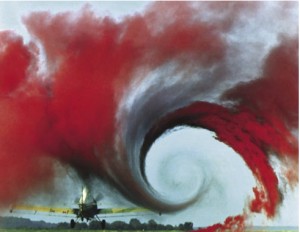 On Monday April 18th a Boeing 737 carrying the First Lady was required to discontinue their approach to Andrews Air Force Base because they came too close to a C-17. For those of us who fly often we know air traffic control may accidentally bring us too close to a larger plane in front of us and we must execute a go around, but when the First Lady is on board it makes the news. All the media attention to this event gives us a perfect opportunity to review the concept of wake turbulence and the regulations and procedures we should use to avoid an encounter with the wake of a large aircraft.
On Monday April 18th a Boeing 737 carrying the First Lady was required to discontinue their approach to Andrews Air Force Base because they came too close to a C-17. For those of us who fly often we know air traffic control may accidentally bring us too close to a larger plane in front of us and we must execute a go around, but when the First Lady is on board it makes the news. All the media attention to this event gives us a perfect opportunity to review the concept of wake turbulence and the regulations and procedures we should use to avoid an encounter with the wake of a large aircraft.
What is Wake Turbulence?
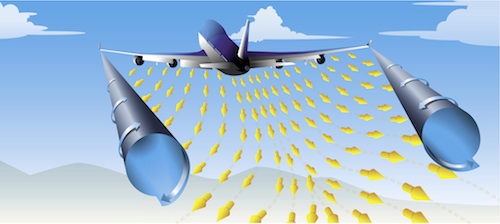
During flight the air pressure above the wing is less than the air pressure below the wing. Since air flows from low to higher pressure the air below the wing will try to flow upwards along the path of least resistance. Since the fuselage blocks the flow, the path of least resistance is towards the wingtips. The air on top of the wing tends to flow slightly towards the fuselage where a vortex is also generated but because of the fuselage disrupting the flow this vortex is insignificant.
Now we have air curling up over the wing tips and flow from the top of the wing downward called down wash. The two combine at the wingtip and create a fast spinning vortex similar to horizontal tornadoes trailing the aircraft. You can see these vortices in person if you sit at the end of a runway and watch a very large aircraft land. Many times you will see the vortex bend towards the ground setting up mini tornadoes sucking up dirt and debris as the vortex travels along the ground.

The vortex or wake from an aircraft is only produced when the airplane is creating lift and increases as the wings angle of attack is higher. As a review the angle of attack is the angle between the wing cord line and the relative wind which is opposite the flight path. The greater the angle of attack the greater the pressure differential between the bottom and top of the wing. The largest wake an aircraft will produce is when an aircraft's angle of attack is highest which is when the aircraft is heavy, clean, or slow.

Vortex Behavior
The trailing vortex of an aircraft is not usually visible making them hard to avoid if you don’t know the behavior of an aircraft’s wake after the plane passes through a section or air. To help you avoid the wake of a large aircraft there are some tools we can use based on the action of the wake.

The wake of an aircraft begins from the moment the wing produces lift. Therefore from the moment the plane begins to rotate until the plane lands and the weight of the aircraft is transferred to the wheels there is a vortex being produced.
The vortex of the aircraft trails behind the aircraft and is slightly less than the wingspan of the aircraft. The vortex will normally move downward at rates of two hundred to three hundred feet per minute. Away from the surface the vortex will be influenced and travel with the wind normally stopping between five hundred to one thousand feet below the aircraft.

Within one hundred to two hundred feet above the ground the vortex will move down and outward traveling sideways or laterally along the ground at approximately two to three knots. The vortices near the ground are also subject to influence from the wind. The most dangerous situation is a tailwind from the left or right side of the runway because the vortex tends to stay over the runway.
Wake Turbulence Avoidance
The best way to avoid the wake of a preceding aircraft is to stay well behind and above the wake. To do this we must visualize where the wake is and where we should position our aircraft to avoid the wake.
Landing
When landing behind an aircraft on the same runway stay at or above the approach path of the preceding aircraft touching down beyond the preceding aircraft’s touchdown point.
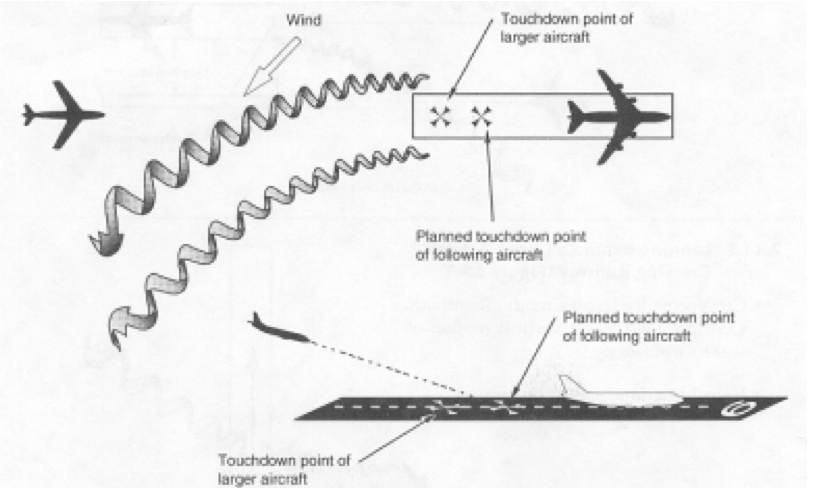
When landing behind a heavy aircraft on a parallel runway closer than two thousand five hundred feet anticipate the vortex drifting onto the runway you are using. Again try to land beyond the touchdown point of the aircraft on the parallel runway.
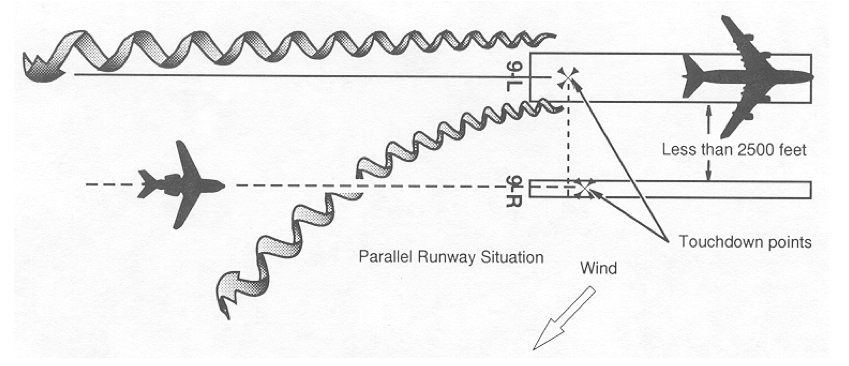
When landing behind a heavier aircraft landing on a crossing runway stay above and land beyond the path of the heavy aircraft.
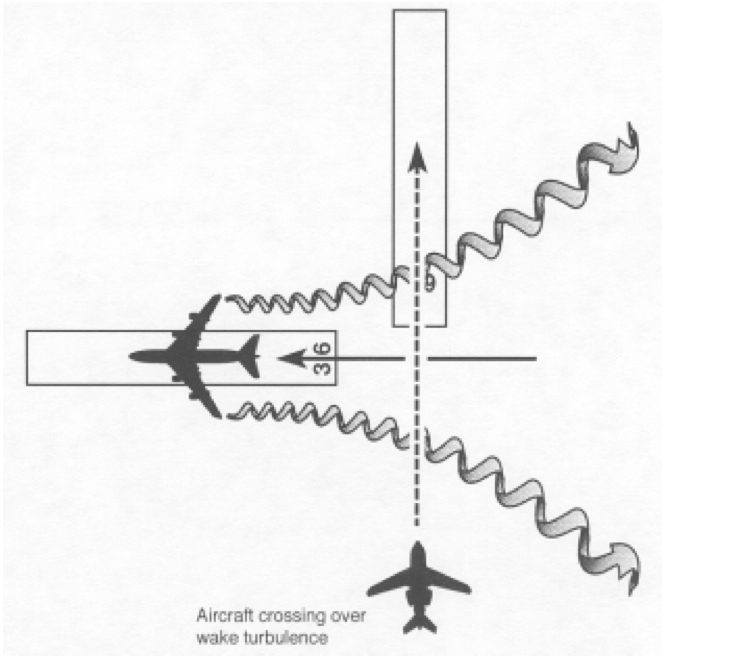
When landing behind a heavy aircraft departing on an intersecting runway rotate before the preceding aircraft’s rotation point. If the heavier aircraft rotates prior to the intersection of the runway you are landing on then go around.
Departing
When departing behind a heavier aircraft on the same runway rotate prior to the heavy aircrafts rotation point and climb above the heavy airplane’s flight path. This might require a turn after takeoff.

If departing after a heavier aircraft did a low approach, touch and go, or a go around wait at least two minutes before departing. The vortices will descend below the flight path and will also move laterally if the plane was within two hundred feet of the ground. The vortices may stay over the runway especially in a light quartering tailwind. The best action would be to wait two minutes before departure.
Even if you fly out of an airport with small planes the airport close to you might handle large jet traffic. This is the case in the airport I fly out of which is on the same approach and departure path as an Air Force Base. I have a friend who was approaching our small airport when he was rolled by a large military transport aircraft flying across his path. Luckily he was a aerobatic pilot and took this in stride and just rolled with the vortex and recovered.
Enroute
While enroute avoid being below and behind a larger aircraft. The best avoidance if you find your self below a larger aircraft’s wake is to move laterally, preferably upwind from the aircraft’s path.
Air Traffic Control Procedures and Wake Turbulence.
While landing or taking off visually behind a heavy aircraft or a Boeing 757 you will be issued the cautionary advisory “caution wake turbulence” followed by the position, altitude and direction of flight.
If you are directly behind and aircraft in a radar environment Air Traffic Control will give you certain minimum separation standards. Any aircraft within two thousand five hundred feet of the flight path of another aircraft is considered behind another aircraft. Using this standard, aircraft operating on runways less than two thousand five hundred feet apart will be treated as if landing on the same runway and be considered behind the preceding aircraft.
Separation standards while under radar control vary based on the size of the aircraft you are following and the size of your aircraft. Aircraft are classified into three categories based on weight. A heavy aircraft is one that weighs 300,000 pounds or more. A large aircraft is one that weights more than 41,000 pounds but less then three hundred thousand. A small aircraft is any aircraft forty one thousand pounds or less.
The FAA has interim procedures for aircraft following the Airbus 380. Aircraft flying behind an A380 will be separated by 6 miles for a heavy aircraft, 8 miles for a large aircraft , and 10 miles for a small aircraft.
If the following aircraft comes within this distance the air traffic controller will separate them by changing the direction of the following aircraft or in the case of a landing aircraft make the plane go around. An example of this occurring is when the plane carrying the First Lady was issued a clearance by air traffic control to discontinue the approach because they came within the separation standards of the preceding heavy C17.
Wake Turbulence Avoidance Is Everyone's Responsibility
Air traffic control does a great job of keeping us safe while we are flying in the clouds but they are human and make mistakes. That is why it is important to try to listen to not only the clearances given to you by ATC but also to listen to other aircraft on the radio. This will increase your awareness of the situation tremendously.
If you see the aircraft in front of you and tell ATC that you have the preceding aircraft in sight they will issue you a caution “wake turbulence” but you are on your own in providing separation from the preceding aircraft's wake. If you do get too close to the proceeding aircraft, Air Traffic Control should issue you a caution and the distance from the proceeding heavier aircraft. If they tell you to abandon the approach and go around you should immediately begin your missed approach or go around.
It is important to realize that although it is everyone's’ responsibility to avoid wake turbulence the pilot is responsible for and is the final authority to the operation of the aircraft. Positioning yourself away from the wake of the aircraft in front of your aircraft may at times be the responsibility of ATC but ultimately the pilot in command must decide if you are at a safe distance and altitude.
Safe Flying!
For More Information:
NTSB releases new details on Obama flight incident

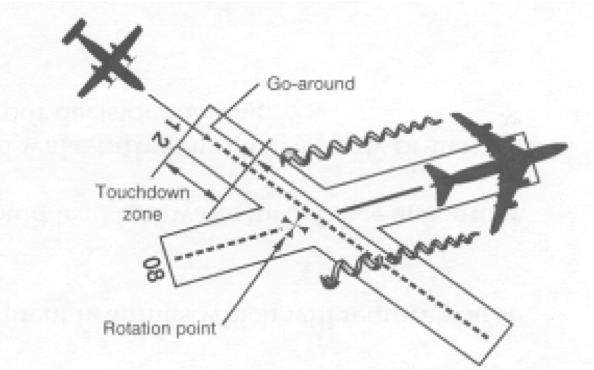

Comments on this entry are closed.
Twin-engined Piper lost control while flying below Airbus flight path, says report
Read more: http://www.theprovince.com/news/Wake+turbulence+caused+crash/4858397/story.html#ixzz1NkAseTM1